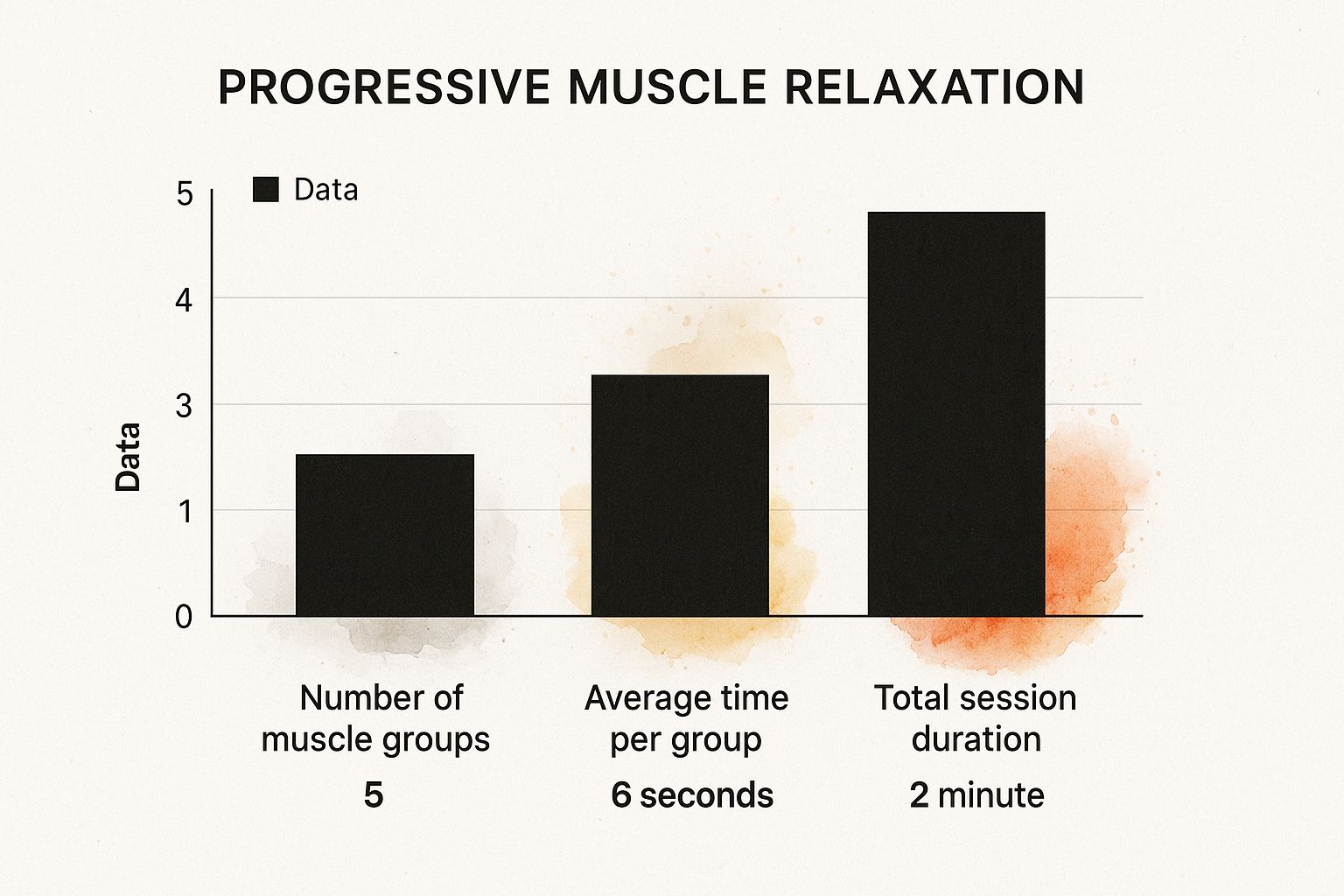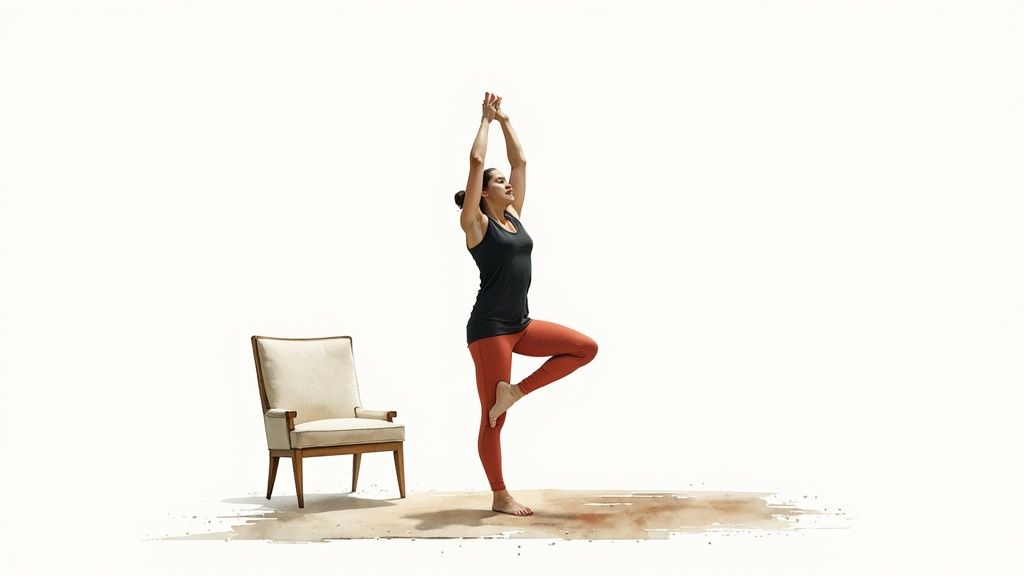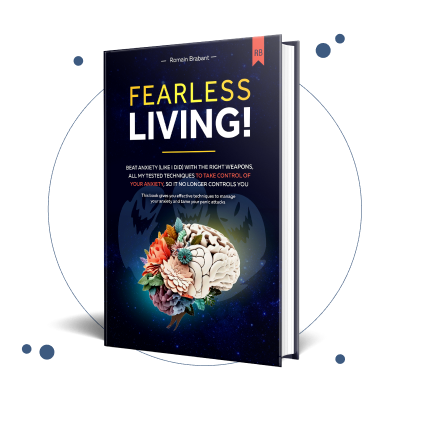
When anxiety floods your system, it feels like you've completely lost the plot. The real secret to learning how to calm down fast is realizing you can take back the controls, one small, deliberate action at a time. This isn't just about managing a moment of panic; it's about walking a path toward a life where you feel confident and in charge.
This isn't about pretending the feeling isn't there. It's about actively guiding your mind and body back to a place of balance, knowing that a calmer, panic-free life is absolutely within your reach.
Your Path From Panic to Lasting Peace
Feeling overwhelmed is a deeply human experience, but it doesn't have to be your entire story. This guide is built on a fundamental truth: you are not broken. You already have what it takes to navigate these intense moments with more confidence than you think, and each time you do, you're one step closer to lasting freedom from anxiety.
We're going to move way beyond the useless advice like "just relax." Instead, we'll dive into practical, science-backed techniques that actually offer immediate relief when your thoughts are racing and your heart feels like it's about to pound out of your chest.
More than that, this is about creating real hope. Every single time you successfully ride out a wave of anxiety, you're literally rewriting your brain's response to stress. Each small win builds long-term resilience, paving a path away from panic and toward a life of genuine calm and self-trust. It’s a journey of healing, and it is entirely possible.
It’s all about learning to understand the signals your body is sending you—and responding with intention instead of fear.
Building a Foundation of Hope
The journey toward a panic-free life is absolutely possible. It starts by understanding that high anxiety, or even a full-blown panic attack, is a temporary state. It’s a moment in time, not a permanent identity. These feelings are manageable, and you can learn to move through them with skill and confidence.
Getting a handle on what’s happening in your body during these episodes is the first step in taking your power back. To learn more about the physical and mental signs, you can read up on the signs of a panic attack and how to manage them. Knowledge really is power here.
This guide isn’t about quick fixes; it’s about giving you a toolkit for life. By learning these skills, you've already taken the most important step forward on your healing journey.
This whole process rests on a few key pillars:
- Understanding Your Body's Response: Recognizing the physiological signs of fight-or-flight helps you see it as a natural, biological process you can influence—not a personal failing. This knowledge empowers you to work with your body, not against it.
- Practicing Actionable Techniques: When you consistently use methods like grounding and controlled breathing, you're training your nervous system to regulate itself more effectively over time. It's like building a muscle, one that makes you stronger and more resilient.
- Cultivating Self-Compassion: Acknowledging that healing isn't a straight line allows you to be kind to yourself through the inevitable ups and downs. This isn't a race, and every step, no matter how small, is progress toward the peaceful life you deserve.
Ground Yourself in the Present Moment

Anxiety loves to drag you into a chaotic future filled with endless "what-ifs." To learn how to calm down fast, you have to pull your focus back and anchor it firmly in the present. This is where grounding techniques become your superpower, showing you that you can find safety and stability even when your mind feels like a storm.
Grounding is really just the simple act of using your five senses to reconnect with whatever is happening around you, right now. This sends a powerful signal to your brain’s alarm system, letting it know you’re safe and effectively short-circuiting that fight-or-flight response.
One of the most powerful and discreet methods I’ve come across is the 5-4-3-2-1 technique. The best part? It requires no special equipment and you can do it anywhere—from a packed meeting room to the middle of a grocery store aisle. It's a reliable tool you can always count on.
How to Use the 5-4-3-2-1 Method
The whole point here is to deliberately shift your focus from the storm inside your head to the world outside. Instead of getting swept away by racing thoughts, you methodically engage each of your senses to pull yourself back to solid ground. It’s a simple, structured way to hit the brakes on a panic spiral before it picks up speed.
Here’s how it works:
- 5 – SEE: Look around the room and silently name five things you can see. Don’t just glance—really observe them. Notice the specific wood grain on your desk, the exact shade of blue on a coworker's pen, or the way the light catches your watch.
- 4 – TOUCH: Now, bring your awareness to four things you can physically feel. This could be the rough texture of your jeans, the cool smoothness of your phone screen, the solidness of the chair beneath you, or the soft fabric of your sweater.
- 3 – HEAR: Listen closely for three distinct sounds. Tune into the quiet hum of the air conditioner, the distant rumble of traffic, or even the soft tapping of your own fingers on a tabletop.
- 2 – SMELL: Identify two different smells in your environment. Maybe you can catch the faint aroma of coffee brewing down the hall or the clean, subtle scent of the soap on your hands.
- 1 – TASTE: Finally, focus on one thing you can taste. It might be the leftover flavor of your morning tea, the mint from your toothpaste, or just the simple, neutral taste inside your mouth.
This technique is so effective because it forces your brain to switch gears from abstract worry to concrete, sensory data. You literally can't be lost in a future catastrophe while also focusing on the texture of your chair.
The beauty of the 5-4-3-2-1 method lies in its subtlety. No one around you even needs to know you're doing it. It’s your own private, powerful tool for taking back control and reminding your nervous system that you are safe, right here in the present moment.
This is just one of many ways to get grounded. If you're looking for more options, you can explore a whole range of grounding techniques for anxiety to see what else clicks. The key is to find a practice that feels natural and easy to access, so it becomes a reliable skill you can call on whenever you need it most on your journey to healing.
Use Your Breath to Regain Control

When your heart is pounding and your thoughts are racing, your breath is the fastest, most direct tool you have to get back in the driver's seat. It's not about taking a single, random deep breath; it's about using specific, intentional breathing patterns to talk directly to your nervous system.
Think of your breath as a remote control for your body’s stress response. By deliberately changing its rhythm and depth, you send powerful signals to your brain that the danger has passed, telling it to switch off the internal alarm bells. This is a skill you can practice and perfect, giving you a reliable way to ground yourself and build a future with less panic.
The need for these skills has never been more critical. Globally, an estimated 284 million people live with anxiety disorders, and in the U.S., nearly half of all workers report stress-related behavioral changes. This reality highlights just how essential immediate, effective calming methods are. Learning to consciously use your breath is a massive step toward building that resilience and living a calmer life.
How a Simple Breath Calms You Down
So, what's happening behind the scenes? Specific breathing techniques work by stimulating the vagus nerve, a major player in your parasympathetic nervous system—your body's "rest and digest" network. When you activate this nerve through slow, deep breathing, it responds by slowing your heart rate and lowering your blood pressure.
This isn't just a psychological trick; it's a physiological command. You're actively stepping in and overriding the fight-or-flight response.
The real hope lies in knowing you can consciously pilot your own physiology. You're not a passive victim of your anxiety; you are an active participant in your own calming and healing process.
Box Breathing: Your Anchor in the Storm
One of the most effective and easy-to-remember techniques is Box Breathing. It gets its name from its simple, four-sided structure, which makes it perfect for those high-stress moments when you can't possibly follow complex instructions.
Here’s the simple pattern to follow:
- Inhale slowly through your nose for a count of four.
- Hold your breath gently for a count of four.
- Exhale slowly through your mouth for a count of four.
- Hold at the bottom of the exhale for a count of four before repeating.
The holds are just as important as the breaths themselves. They prevent the shallow, rapid breathing that fuels panic, forcing your system to slow down and find a steady, calming rhythm. Practicing this for just one or two minutes can make a world of difference.
There are many great breathing exercises for anxiety out there, so it's worth exploring to see what resonates with you. To really master this vital tool, you can also check out these 7 breathing techniques for reducing stress. Remember, each breath is a step back toward peace and a powerful reminder that you are in control.
Shift Your Body to Calm Your Mind
Anxiety isn't just in your head—it's a full-body experience. When you're anxious, your system gets flooded with stress hormones like adrenaline and cortisol. This is what causes your heart to race, your breathing to get shallow, and your muscles to clench up as if you're bracing for impact.
To learn how to calm down fast, you have to work with your body, not against it.
By intentionally releasing that physical tension, you send a powerful message back to your brain: "The threat is over. You can stand down." It’s a direct line to your nervous system, effectively interrupting the panic cycle and helping you feel in control again. Each time you do this, you reinforce the belief that you can manage these feelings and live a life free from their grip.
And the best part? You don't need some complicated, hour-long routine. Simple, deliberate physical shifts can have a profound and almost immediate impact on your mental state.
Progressive Muscle Relaxation
One of the most effective and time-tested techniques is Progressive Muscle Relaxation (PMR). It’s a simple practice of tensing specific muscle groups for a few seconds and then letting them go completely.
The process does two things brilliantly. First, it forces you to become aware of just how much tension you were unknowingly holding onto. Second, the release is deeply, physically satisfying. It’s like your muscles can finally breathe again. By zeroing in on this physical sensation, you pull your focus away from racing thoughts and directly soothe your body's stress response.

As the infographic shows, you can complete a full, effective cycle in just two minutes. That makes it an incredibly practical tool you can use almost anywhere—in your car, at your desk, or even in a bathroom stall if you need a quick reset.
Using Cold to Reset Your System
Here's another powerful physiological hack: use cold to your advantage. Splashing your face with cold water or even just holding an ice pack against your wrists or the back of your neck can trigger something called the mammalian dive reflex.
This is a primal, built-in response that instantly slows your heart rate and redirects blood flow to your core organs. Think of it as a biological reset button for your nervous system. It's a surprisingly fast and effective way to halt the physical momentum of panic in its tracks.
Strategic Movement and Posture
Sometimes, that surge of adrenaline just needs to go somewhere. Trying to sit still with all that buzzing energy can feel impossible and might even make the anxiety worse. The key is to give it a healthy outlet.
This doesn’t mean you have to drop and do 50 push-ups. A brisk walk around the block, vigorously shaking out your arms and legs, or doing a few big stretches can make all the difference. You're literally burning off the stress hormones.
Your posture plays a surprisingly big role, too. When we feel anxious or defeated, we tend to slouch, which can actually reinforce those feelings of powerlessness. Conversely, standing up straight with your shoulders back can send a signal of confidence to your brain.
Our guide on how power poses can boost confidence and reduce anxiety dives deeper into this connection. By consciously changing how you hold yourself, you can directly influence how you feel.
Quick Physical Calming Techniques
When you feel anxiety rising, a rapid physical intervention can ground you in minutes. The right technique often depends on where you are and what you need in that moment.
Here’s a quick comparison to help you choose the best tool for the job.
| Technique | Best For | Time Required | How It Works |
|---|---|---|---|
| Progressive Muscle Relaxation | Releasing hidden muscle tension when you can sit or lie down quietly. | 2-5 minutes | Tensing and releasing muscles sends direct calming signals to the brain. |
| Cold Water Splash | A sudden, intense spike of panic that needs an immediate "shock" to the system. | 30 seconds | Triggers the mammalian dive reflex to instantly slow your heart rate. |
| Brisk Walk or Shaking Limbs | Burning off restless, "buzzy" energy and adrenaline when you feel fidgety. | 1-5 minutes | Provides a physical outlet for stress hormones, preventing them from building up. |
| Power Posing | Combating feelings of helplessness or low confidence in a social or performance setting. | 2 minutes | Adopting an expansive posture can decrease cortisol and increase feelings of power. |
Each of these techniques leverages the mind-body connection in a different way. Experiment to see which one feels most effective for you and keep it in your back pocket for when you need it most.
The real hope here is understanding you have physical tools at your disposal anytime, anywhere. You can actively change your body's chemistry to calm your mind, proving you have more power over anxiety than you think. This is a crucial part of the healing journey.
Managing Anxiety in the Workplace
The professional world can feel like a pressure cooker. With deadlines looming and expectations running high, trying to manage a racing heart before a big meeting or scattered thoughts during a presentation is a silent battle many of us fight every day.
Learning how to calm down fast at work isn’t just about survival; it’s a critical professional skill that contributes to long-term well-being and success.
These moments don't have to derail your focus or your career. The good news is you can build a toolkit of discreet, effective strategies to regain your composure right at your desk. These aren't just temporary fixes; they’re tools that empower you to protect your well-being and prove you can thrive in high-pressure situations, creating a more sustainable and panic-free work life.
And this isn't a small issue. The scale of workplace stress has massive global repercussions. Depression and anxiety disorders cost the global economy an estimated $1 trillion each year in lost productivity. In the U.S. alone, job-related stress racks up over $300 billion in annual costs. You can find more insights on the economic and health impacts of workplace stress at CertifyMe.online.
Discreet Grounding at Your Desk
Imagine you’re in a meeting and you feel that familiar wave of anxiety start to build. You need something subtle, something that won't draw any attention. This is where the 'Desk Anchor' technique comes in.
Simply place both of your hands flat on your desk. Now, bring all your focus to that physical sensation. Notice the cool, smooth surface under your palms, the solid weight of the desk beneath them. Is it wood? Laminate? Feel its texture.
This simple physical connection pulls your attention out of the chaotic storm in your mind and anchors you in the present moment. It’s a powerful, silent reminder that you're in a stable, real environment, even when your internal world feels turbulent.
Create Your Micro-Environment of Calm
Open-plan offices and busy workspaces can be a sensory nightmare. One of the most powerful things you can do is reclaim a little slice of that mental space for yourself by creating a personal bubble of calm.
Noise-canceling headphones are a game-changer for this. You don’t even have to play music; just activating the noise-canceling feature can instantly muffle the surrounding chatter and distractions. It’s a small act of control that gives your nervous system a much-needed break from feeling overwhelmed.
The real power lies in recognizing you can shape your immediate environment to support your mental state. Each small adjustment is a step toward building a more resilient, panic-free professional life.
Another go-to strategy is the 'reset walk.' Just stepping away from your desk for five minutes can be enough to interrupt a stress cycle before it spirals.
Walk to a different floor, grab a glass of water from the breakroom, or step outside for a quick breath of fresh air. The key is to physically change your environment. This simple shift helps your brain reset, calming your nervous system and clearing your focus.
Building Your Life Beyond Panic

The tools in this guide are your first line of defense. They’re what you grab when the alarm bells start ringing. But the real goal? It's to build a life where those alarms don't go off so often—a life where panic isn’t in the driver’s seat. This is not just a dream; it's an achievable reality.
Learning how to calm down fast is a game-changing skill, but it’s just the first step. True, lasting change comes from using these moments of newfound calm to build unshakable resilience and trust in yourself.
Think of these calming methods less like fire extinguishers and more like foundational bricks. Every time you successfully navigate a wave of panic, you’re not just surviving—you’re proving to yourself that you can handle intense feelings. You’re laying another brick, strengthening your ability to self-regulate and building a future free from fear.
This is how you nurture a deep, quiet sense of hope that doesn’t get rattled easily.
The journey to a panic-free life is real and achievable. By learning to manage these moments, you've already taken the most important step forward on a path of profound healing and empowerment.
Creating Your Path to Lasting Calm
So how do you go from putting out fires to building a fireproof life? You start getting proactive.
One of the best first steps is to create a personalized 'calm-down kit.' This isn't just a box of stuff; it's a collection of sensory anchors. Think about what grounds you. Maybe it's a specific essential oil, a smooth stone you can hold in your palm, or a playlist that instantly soothes your nervous system.
At the same time, you can start to gently uncover your unique triggers. No need for a deep psychoanalysis here—just simple journaling. When you feel that familiar knot of anxiety, jot down what’s going on around you and inside you. Over time, you’ll start to see patterns, and recognizing those patterns is a massive leap toward feeling in control.
From there, you can explore the broader anxiety recovery steps to create a more structured plan for yourself. It also helps to find mindful hobbies that keep your hands busy and your mind calm, like this relaxing needlecraft, which can absorb daily stress before it builds up.
Got Questions? Let's Talk.
Learning to manage anxiety is a journey, and it's totally normal to have questions pop up as you start trying these new skills. This is where we build real, lasting hope—knowing there are answers and a clear path forward to a life without panic.
How Quickly Can I Expect These Techniques to Work?
Many of the methods we've covered, like deep breathing and grounding, are designed to give you relief almost immediately. Their whole purpose is to hit the brakes on that fight-or-flight response.
You can often feel a real shift in your body's stress levels within just a few minutes of practice. The goal isn't to make anxiety vanish instantly, but to stop it from spiraling and bring you back into the driver's seat. Consistency is what turns these into your go-to tools for fast relief and builds confidence in your ability to cope.
Can These Methods Actually Stop a Panic Attack?
Yes, they absolutely can. The trick is to use them at the very first sign of that familiar wave of anxiety. Think of it like catching a small fire before it turns into an inferno.
When you use a grounding technique or a controlled breathing exercise as soon as you feel that flutter of panic, you’re basically telling your body's alarm system to stand down before it hits its peak. It's a powerful way to head off a full-blown panic attack, proving you have the ability to steer yourself back to safety. Each time you succeed, you weaken the power panic has over you.
Remember, the goal isn’t to never feel anxiety again. It’s to trust that you have the skills to manage it when it shows up. That self-trust is everything, and it's the foundation of a panic-free life.
What if a Technique Doesn’t Work for Me?
That's completely normal, and honestly, it's expected. Not every method is going to click with every person, and what works one day might not be the right tool for another.
The key is to approach this with curiosity, not judgment. If one technique doesn't help, just move on and try another. Your journey is about building a diverse toolkit, not finding one single magic bullet.
There is always another strategy to try and more support out there. This whole process is about discovering what works for you, giving you the confidence that you can always find your way back to calm. Healing is possible, and you are capable of finding the path that works for you.
At The Anxiety Checklist, we believe in giving you a structured, actionable plan to build this toolkit for yourself. Our Fearless Living system is designed to guide you from immediate relief to long-term resilience, putting you back in control of your life. Learn more about our approach.

